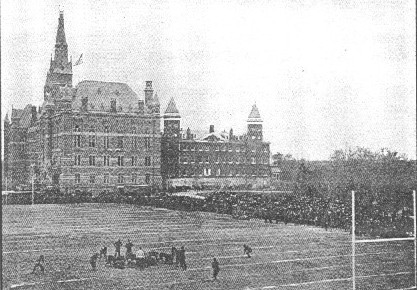Home > History > History Narrative

Georgetown Football History Chapter 2:
"Hub" Hart And A Game To Remember
 James "Hub" Hart, bruising fullback on the football field, professional caliber catcher on the diamond, and conscientious dental student in the classroom, was the primary reason for Georgetown's return to football respectability in the first years of the 20th century. A strong team in the 1890's, Georgetown football was abolished by the administration after the death of team captain George "Shorty" Behan in an 1894 clash. The game was reinstituted on a collegiate level in 1898, but the team's former glory was not regained until Hub Hart hurtled on the scene in 1901.
James "Hub" Hart, bruising fullback on the football field, professional caliber catcher on the diamond, and conscientious dental student in the classroom, was the primary reason for Georgetown's return to football respectability in the first years of the 20th century. A strong team in the 1890's, Georgetown football was abolished by the administration after the death of team captain George "Shorty" Behan in an 1894 clash. The game was reinstituted on a collegiate level in 1898, but the team's former glory was not regained until Hub Hart hurtled on the scene in 1901.
Georgetown was limping through a 1-3-2 campaign in 1901 when first-year man Hart saw his initial action against Gallaudet. The Blue and Gray lost that day, 18-6, but were encouraged by the dynamic performance of their new fullback. He scored the game's lone TD (touchdowns were five points in those days; conversions were needed for the sixth point) while displaying the intensity, strength, and leadership that quickly earned him the nickname "Hub"--an appellation aptly describing his central position in most plays.
Even if his career had ended after the Nov. 16, 1901 game against Virginia, Hub Hart's fame as a Georgetown gridder would have been assured. The local press wrote off the sputtering Blue and Gray just a week before the biggest game of the season. However, they did not reckon with the undying spirit of a Hilltop student body which regularly attended team practices to spur on their classmates or the Herculean efforts of Hub Hart.
The battle in the first half, following the expected course, was more like a slaughter. The burly Virginia team left the field at halftime ahead 11-0. U.Va. retained its dominance in the first part of the second half, taking a 16-6 advantage into the final quarter. A short plunge by Hart was responsible for the Hilltoppers' only score. Things looked bleak for the Blue and Gray, but bolstered by deafening cheers from a partisan crowd of over 5,000, the varsity turned a sullen day into a memorable occasion.
Hart's second touchdown, a three yard burst, sparked the Georgetown victory surge. The final drive began deep in their own territory with less than two minutes remaining. A series of runs by his fellow teammates brought the ball to the Virginia six yard line. From there, Hart took charge. Three straight smashes into a suddenly impregnable Virginia line gained little ground. On what was Georgetown's last hope, Hart took the hand-off, feigned as if to try another line buck, and to the dismay of the Virginia line raced around left end for the winning score, 17-16. The crowd became riotous with joy. Several minutes passed before order could be restored and the game concluded.
A Washington Post article best summarized the contest: "It is the story of how eleven men, outclassed, outweighed, and outgeneraled, crippled, crushed, and beaten in a brawny battle--suddenly rose mightily."
Hub Hart remained a prominent member of the football team until receiving his DDS degree in 1905. During his career he scored 25 touchdowns, set a Hoya record with a 99 yard rush from scrimmage against Maryland, and earned All-America honors in leading the Hoyas to a 7-1 record in 1904. "Hub" was elected to the Georgetown Hall of Fame after the 1904 season, his enshrinement both a tribute to his skill and his role in reestablishing Georgetown's preeminent stature on the gridiron.
Hub Hart also excelled in baseball. He played right field and catcher, helping the 1904 unit to a 16-11 mark with victories over Eastern powers like Navy, Princeton, Villanova, and Brown. Upon his graduation from GU, Hart became a substitute catcher with the Chicago White Sox. His three year career with the Pale Hose included a World Series appearance with the "Hitless Wonders" of 1906, conquerors of the Chicago Cubs team famous for its "Tinker to Evers to Chance" double play combination.
After retiring from baseball, Hart practiced dentistry in Fort Wayne, Indiana. It was there that Hub Hart died from a hear attack on October 10, 1960, almost sixty years after his most memorable day on the Georgetown gridiron.
Excerpted from The HOYA and its 1981-1982 series "Great Moments In Georgetown Sports", by Bill Ferraro. Mr. Ferraro graduated from Georgetown with an A.B. in American Studies in 1982 and received his Ph.D. from Brown University. He is presently a professor at Southern Illinois University.
Home > History > To Chapter 3
HoyaSaxa.com:
The One-Stop Web Site For Hoya Football™
An independent web site not affiliated with Georgetown University. All rights reserved.